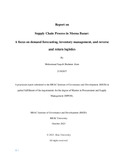Supply chain process in Meena Bazar: a focus on demand forecasting, inventory management, and reverse and return logistics
Abstract
The practicum is all about the supply chain process at Meena Bazar and the new theories or methods that have been tried to implement to observe new horizons of the overall supply chain management.
Among Bangladesh's biggest chains of retail supermarkets, Meena Bazar was founded in 2002. At the moment, it functions in Chittagong, Savar, Narayanganj, and Dhaka. Every one of its 29 locations is open seven days a week to provide services, including home delivery. Customers may purchase over 10,000 things from it, and it offers easy parking, a convenient shopping experience, and top-notch customer service.
Meena Bazar is a division of Bangladesh's renowned Gemcon Group. It is renowned for producing fresh veggies and meals, dairy goods, and organic and herbal products. Meena Bazar teaches its patrons about the advantages of leading a healthy lifestyle in addition to offering them these kinds of products.
The main objective of this practicum is to analyze the current supply chain process of Meena Bazar and coming up with recommendations of different methods for overall progress.
To analyze the total supply chain process of Meena Bazar, three key contributing portions have been selected to work further. Those are demand forecasting, inventory management and reverse supply chain and logistics management, reverse supply chain and logistics management.
After analyzing these processes, some new methods (which were not applied previously in the current process) have been applied in these processes as part of the practicum. These methods
pg. 7
were learnt by me through the various courses which I have completed during my MPSM tenure. These below mentioned concepts and other methods which I have learned from the MPSM coursework helped me to understand the procurement and supply chain management process with more knowledge. Here, the selective methods which I have applied with the help of my coursework to my workplace are:
Qualitative Forecasting: In order to predict future events or trends, qualitative forecasting makes use of expert opinions, market research, and subjective judgment. Qualitative forecasting techniques rely on human judgment and qualitative data, as opposed to quantitative forecasting, which makes forecasts using mathematical models and historical data.
Collaboration, Planning, Forecasting and Replenishment (CPFR): The goal of the collaboration, planning, forecasting, and replenishment (CPFR) business approach is to increase trading partners' communication and cooperation in order to increase supply chain efficiency. Retail, consumer products, and manufacturing are three industries that frequently use CPFR because of their intricate and interconnected supply chains.
Just in Time (JIT): Just in Time (JIT) is a production and inventory management approach in which materials, products, and components are delivered and used exactly at the time they are needed in the production process. The goal of JIT is to minimize waste, reduce production and carrying costs, and improve efficiency by synchronizing production closely with demand.
pg. 8
Return Management System (RMS): A Return Management System (RMS) is a set of processes and tools designed to handle product returns efficiently and effectively. It is a crucial component of supply chain and customer relationship management, enabling businesses to manage returned merchandise, reduce losses, and enhance customer satisfaction.
Upon finding and observing the current process and implementing new ones, some recommendations have been made:
1. Qualitative forecasting should be combined with the current forecasting method i.e. quantitative forecasting for a more appropriate forecasting.
2. Proper collaboration within departments for both inventory management and demand forecasting are highly needed.
3. Steps should be taken to minimize inventory and holding costs.
4. Return management system software should be introduced to minimize the hassle regarding reverse supply chain.

